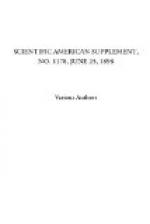the pressure may sink to 95-100 mm.; but if the pressure
be taken of the same subject lying in bed, and quietly
engaged on mental work, it will be found to be no
higher. By mental strain or muscular effort, the
pressure is, however, immediately raised, and may then
reach 130-140 mm. of mercury. It can be seen
from considering these facts that the fall of pressure
is concomitant with rest, rather than with sleep.
As, moreover, it has been determined on strong evidence
that the cerebral vessels are not supplied with vasomotor
nerves, and that the cerebral circulation passively
follows every change in the arterial pressure, it
becomes evident that sleep cannot be occasioned by
any active change in the cerebral vessels. This
conclusion is borne out by the fact that to produce
in the dog a condition of coma like to sleep, it is
necessary to reduce, by a very great amount, the cerebral
circulation. Thus, both carotids and both vertebral
arteries, can be frequently tied at one and the same
time without either producing coma or any very marked
symptoms. The circulation is, in such a case,
maintained through other channels, such as branches
from the superior intercostal arteries which enter
the anterior spinal artery. While total anaemia
of the brain instantaneously abolishes consciousness,
partial anaemia is found to raise the excitability
of the cortex cerebri. By estimation of the exchange
of gases in the blood which enters and leaves the
brain, it has been shown that the consumption of oxygen
and the production of carbonic acid in that organ is
not large. Further, it may be noted that the
condition of anaesthesia is not in all cases associated
with cerebral anaemia. Thus, while during chloroform
anaesthesia the arterial pressure markedly falls, such
is not the case during anaesthesia produced by ether
or a mixture of nitrous oxide and oxygen.
The arterial pressure of man is not lowered by the
ordinary fatigue of daily life. It is only in
extreme states of exhaustion that the pressure may
be found decreased when the subject is in the standing
position. The fall of pressure which does occur
during rest or sleep is mainly occasioned by the diminished
rate of the heart. The increase in the volume
of the limbs is to be ascribed to the cessation of
muscular movement and to the diminution in the amplitude
of respiration. The duty of the heart is to deliver
the blood to the capillaries. From the veins
the blood is, for the most part, returned to the heart
by the compressive action of the muscles, the constant
change of posture and by the respiration acting both
as a force and suction pump. All of these factors
are at their maximum during bodily activity and at
their minimum during rest. On exciting a sleeper
by calling his name, or in any way disturbing him,
the limbs, it has been recorded, decrease in volume
while the brain expands. This is so because the
respiration changes in depth, the heart quickens, the
muscles alter in tone, as the subject stirs in his




